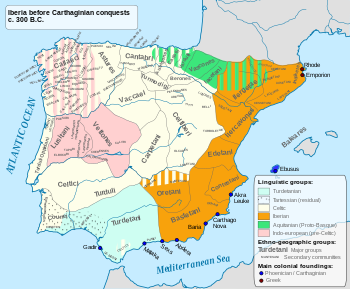Bardili (Turduli)

The Bardili were a small, pre-Roman tribe of the Iberian Peninsula, and an offshoot of the widespread Turduli people, who lived in what is now southwestern Portugal in the 5th-1st centuries BC.
Location
[edit]Migrating in conjunction with the Celtici,[1][2][3] they settled the present Setúbal peninsula along the Tagus river mouth and the lower Sardum[4] (Sado; Kallipos in the Greek sources[5]) river valley around the 5th Century BC, where they founded several coastal towns. The exact location of the Bardili capital Bardo remains uncertain, though the towns of Equabona/Aquabona (Coina-a-Velha), Caetobriga/Cetobriga (Monte da Rotura, near Setúbal) and Salacia (Alcácer do Sal; Iberian-type mint: Ketuvion) have all been identified.[6]
History
[edit]In the mid-3rd century BC the Bardili were forced to acknowledge the suzerainty of Carthage at the latter part of the century. However, their history after the Second Punic War is unclear; they seem to have played no role in the Lusitanian Wars and subsequent conflicts during the 2nd-1st Centuries BC. It is almost certain that the Bardili recovered their independence, which they enjoyed for nearly a century before being included into Hispania Ulterior province by the Praetor Publius Licinius Crassus in the wake of his campaign against the Lusitani and Celtici in 93 BC.[7] Later during the Sertorian Wars in 79 BC, Proconsul Quintus Caecilius Metellus Pius established a permanent military base at Caeciliana (near Setúbal), in order to prevent the Bardili from lending their support to Quintus Sertorius.[8]
Romanization
[edit]Increasingly Romanized after the Ulterior Propraetor Julius Caesar campaigns against the Lusitani, Turduli Oppidani, and Turduli Veteres in 61-60 BC,[9] they were aggregated to the new Lusitania province by Emperor Augustus in 27-13 BC.
See also
[edit]- Cynetes
- Lusitanian Wars
- Turduli
- Turduli Veteres
- Turduli Oppidani
- Pre-Roman peoples of the Iberian Peninsula
Notes
[edit]- ^ Strabo, Geographikon, III, 3, 5.
- ^ Pomponius Mela, De Chorographia, III, 8.
- ^ Pliny the Elder, Natural History, IV, 112-113.
- ^ Avienius, Ora Maritima, 150.
- ^ Ptolemy, Geographiké Hyphegésis, II, 5.
- ^ Pliny the Elder, Natural History, IV, 116-118.
- ^ Plutarch, Marcus Crassus, 14, 1.
- ^ Matyszak, Sertorius and the struggle for Spain, p. 144.
- ^ Cassius Dio, Romaïké istoría, 37, 52-55.
References
[edit]- Ángel Montenegro et alii, Historia de España 2 - colonizaciones y formación de los pueblos prerromanos (1200-218 a.C), Editorial Gredos, Madrid (1989) ISBN 84-249-1386-8
- Jorge de Alarcão, O Domínio Romano em Portugal, Publicações Europa-América, Lisboa (1988) ISBN 972-1-02627-1
- Jorge de Alarcão et alii, De Ulisses a Viriato – O primeiro milénio a.C., Museu Nacional de Arqueologia, Instituto Português de Museus, Lisboa (1996) ISBN 972-8137-39-7
- Luis Berrocal-Rangel, Los pueblos célticos del soroeste de la Península Ibérica, Editorial Complutense, Madrid (1992) ISBN 84-7491-447-7
- Philip Matyszak, Sertorius and the struggle for Spain, Pen & Sword Military, Barnsley (2013) ISBN 978-1-84884-787-3
External links
[edit]- Berrocal-Rangel, Luis (2005). "The Celts of the Southwestern Iberian Peninsula". e-Keltoi: Journal of Interdisciplinary Celtic Studies. 6: 481–96.
